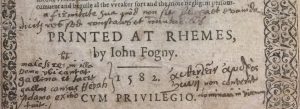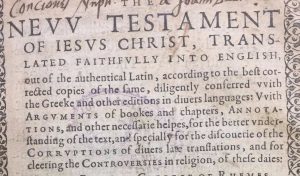Today’s blog post will focus solely on one of the bibles that were discussed in my last blog. I will focus on the bible that I referred to as the Fogny Bible. As my research continued over the week, I discovered that my initial understanding of the Fogny Bible was incorrect. The book was not, in fact, printed in England. I was quick to assume that this was the case due to the language used and the publisher being “The English College of Rhemes”, but failed to realize that this was actually a location in France.

So this begs the question, why was there a need to have an English College in France? Why is this book printed in English in a country that does not speak the language? This deeper look into the Fogny Bible also brought up some ideas that did not previously arise. I believe that this book is actually Catholic in nature. I believe this because on the title page of the Fogny Bible it states, “Translated Faithfully Into English from the Authentical Latin”.

This clues into the book’s Catholic nature. Catholics claimed that the only translations of the bible that could be true and authentic must come from the Latin Vulgate, translated from the original Hebrew and Greek by St. Jerome. Another thought to consider is the history of the publication of New Testaments by Catholics. Erasmus of Rotterdam, who was ordained as a Catholic priest, published a new and edited version of the New Testament in 1516. The Fogny Bible could be a continuation of publications inspired by the Erasmus edition of the New Testament.
So since it is believed that this bible is in fact Catholic in nature, this could explain the reason the book was published in France. In 1582, when the Fogny Bible was published, England was a Protestant country. France, on the other hand, was under Catholic rule. Therefore, it makes sense that Catholics who desired to create these publications would face religious persecution in England, but not in France. It is intriguing to view the Fogny Bible as not just an object as it is viewed today, but how it was viewed by its contemporaries. The publication of such texts, despite the extremity of the religious tension that encapsulated Europe at this time, displays just how important this bible was to those who came in contact to with it. The Fogny Bible could have been symbolic to its owners, and verified their beliefs, even during a time where those beliefs were challenged. I think that this idea, of holding onto one’s beliefs even in a time of hate and discrimination applies to current events. Religious persecution is not something that has been left behind in history; it is something that people face on a daily basis. That is why I find the Fogny bible not only so interesting, but so relevant.